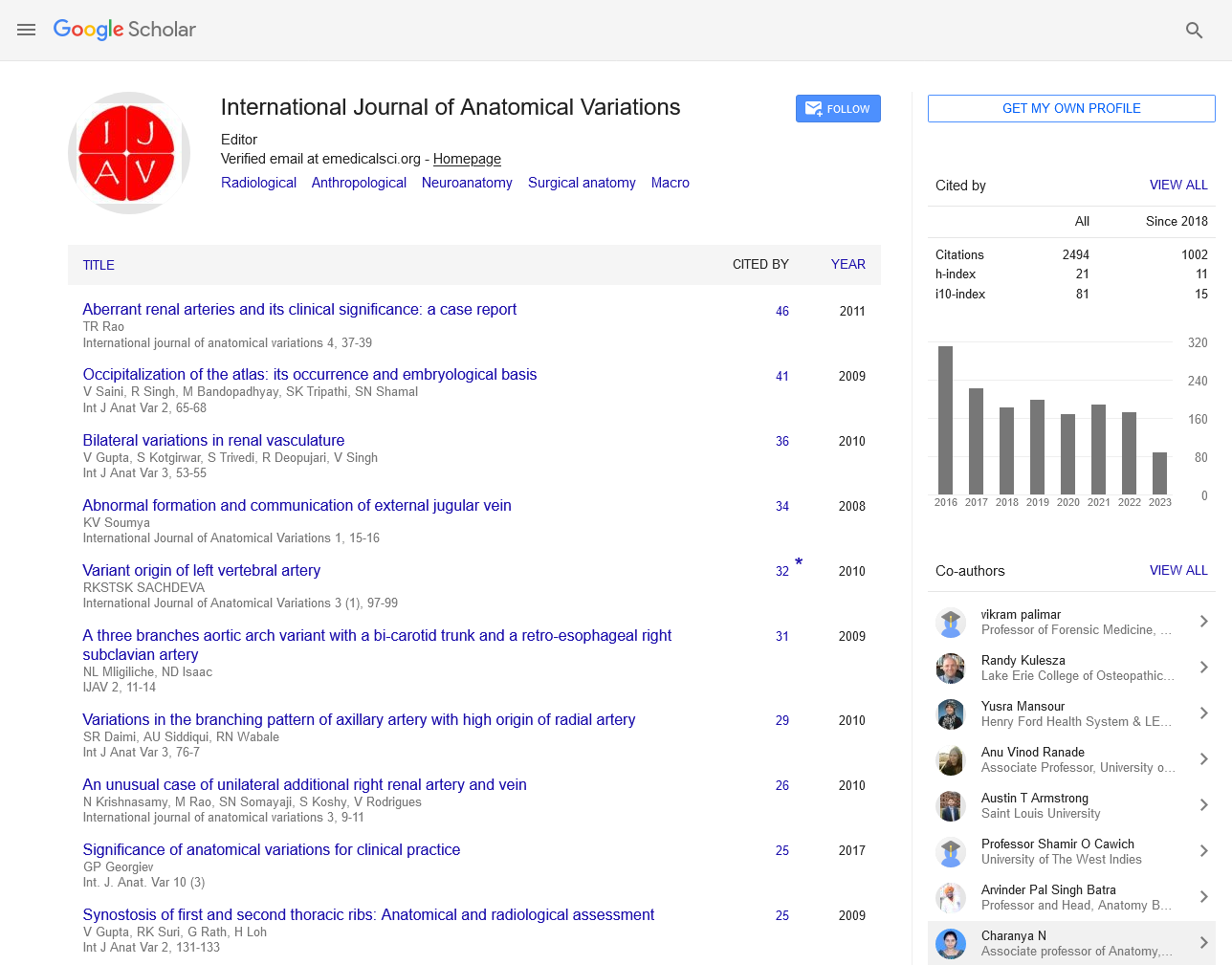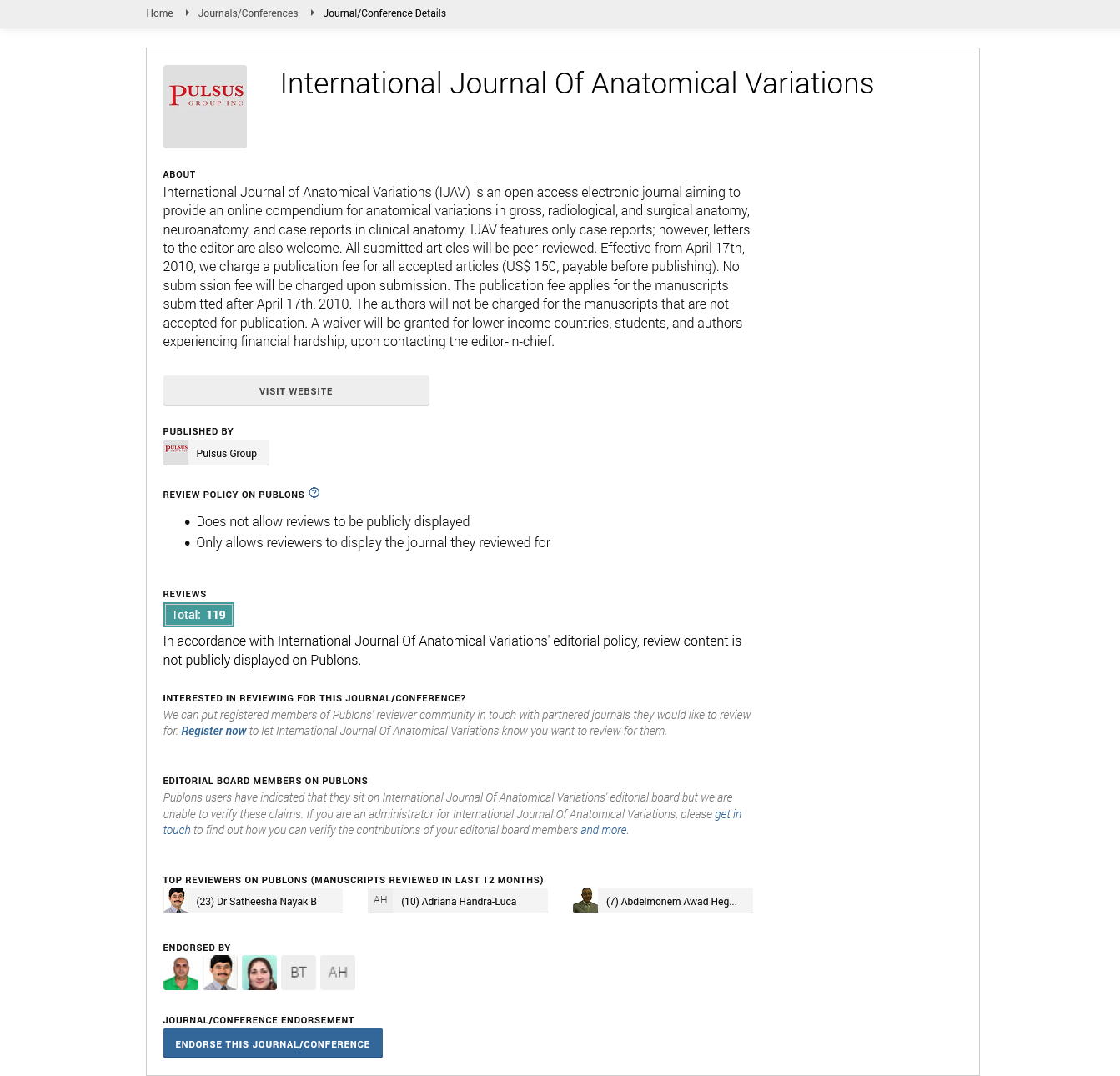Morphological Variations in the Fibular Collateral Ligament and Its Role in Knee Stability
Received: 02-Jan-2025, Manuscript No. ijav-25-7548; Editor assigned: 04-Jan-2025, Pre QC No. ijav-25-7548 (PQ); Reviewed: 18-Jan-2025 QC No. ijav-25-7548; Revised: 24-Jan-2025, Manuscript No. ijav-25-7548 (R); Published: 31-Jan-2025, DOI: 10.37532/1308-4038.18(1).480
Citation: Lopatova ZH. Morphological Variations in the Fibular Collateral Ligament and Its Role in Knee Stability. Int J Anat Var. 2025;18(1): 729-730.
This open-access article is distributed under the terms of the Creative Commons Attribution Non-Commercial License (CC BY-NC) (http://creativecommons.org/licenses/by-nc/4.0/), which permits reuse, distribution and reproduction of the article, provided that the original work is properly cited and the reuse is restricted to noncommercial purposes. For commercial reuse, contact reprints@pulsus.com
INTRODUCTION
The fibular collateral ligament (FCL), also known as the lateral collateral ligament (LCL), is a critical structure in maintaining the stability of the knee joint. This ligament is located on the lateral side of the knee and connects the femur to the fibula. It primarily resists varus forces, preventing excessive inward deviation of the knee. Variations in the morphology of the fibular collateral ligament are relatively common and can significantly influence knee stability, especially in the context of injuries or surgical interventions. Anomalies in the size, shape, and anatomical attachment points of the FCL can alter its function and contribute to pathologies that affect knee function. This article explores the common morphological variations in the FCL, their impact on knee stability, and the clinical implications for diagnosis and treatment [1].
ANATOMY AND FUNCTION OF THE FIBULAR COLLATERAL LIGAMENT
The fibular collateral ligament is a strong, cord-like structure that runs along the lateral aspect of the knee. It originates from the lateral femoral epicondyle, just above the joint line, and inserts onto the head of the fibula. The FCL serves a crucial role in stabilizing the knee joint against varus stress, which is the force that causes the knee to bend outward. In addition to its primary stabilizing function, the FCL also contributes to limiting the internal rotation of the tibia relative to the femur, which is important for maintaining overall knee function and alignment. The FCL consists of two distinct portions: the superficial and deep fibers. The superficial fibers are more prominent and run along the lateral aspect of the knee, whereas the deep fibers are smaller and blend with the joint capsule and the meniscus. Unlike the medial collateral ligament (MCL), the FCL does not attach to the meniscus, which contributes to its relative mobility and makes it less susceptible to simultaneous meniscal injuries. This unique anatomical characteristic also means that injuries to the FCL are typically isolated, although they can occur in combination with other ligamentous injuries [2].
MORPHOLOGICAL VARIATIONS IN THE FIBULAR COLLATERAL LIGAMENT
Morphological variations in the FCL can occur in several forms, including differences in size, shape, attachment points, and the number of ligamentous bands. One of the most common variations is the fibular collateral ligament’s length, which can vary from person to person. In some individuals, the FCL may be longer or shorter than average, which can affect the range of motion and stability of the knee joint. Another key variation involves the fibular collateral ligament’s attachment points. In certain cases, the FCL may be attached higher or lower on the femur or fibula than usual. This alteration in attachment can change the biomechanics of the knee, potentially leading to an increased risk of injury, particularly during activities that involve lateral movements or high-impact forces. Additionally, the FCL can be divided into multiple smaller bundles in some individuals, which can influence the ligament’s overall strength and its ability to resist varus stresses. There are also instances where the FCL may demonstrate additional or accessory fibers. These accessory fibers may be present in a smaller number of individuals and can contribute to variations in knee stability. In some cases, these extra fibers can provide additional support to the joint, while in others, they may increase the complexity of surgical interventions [3].
IMPACT OF FCL VARIATIONS ON KNEE STABILITY
The morphological variations in the FCL can significantly impact knee stability, especially when combined with injuries or pathologies. When the fibular collateral ligament is shorter or has altered attachment points, it may be less effective at resisting varus forces, which could predispose the knee to instability, particularly during activities such as running, cutting, or jumping. A compromised FCL may also lead to increased strain on other structures within the knee, including the anterior cruciate ligament (ACL) and meniscus, potentially causing secondary injuries. Variations in the number of ligamentous bundles can also affect knee function. A more complex or multi-bundled FCL may provide additional support but could also lead to uneven distribution of forces during movement, resulting in an increased risk of strain or injury. Additionally, individuals with accessory fibers may have increased knee stability, but the presence of these extra structures may complicate surgical procedures if ligament reconstruction is required. The role of the FCL in resisting rotational forces is particularly important. Any variation that reduces its ability to stabilize the knee against internal or external rotation can increase the likelihood of rotational instability, which may contribute to conditions such as patellofemoral pain syndrome or chronic lateral instability. These types of injuries are often seen in athletes and individuals who engage in high-risk sports that require sudden directional changes or twisting motions [4].
CLINICAL IMPLICATIONS AND DIAGNOSIS
Morphological variations of the fibular collateral ligament have significant implications for clinical diagnosis and treatment, particularly in the context of ligament injuries. Understanding the normal and variant structures of the FCL is essential for accurate diagnosis, as these variations can influence the results of diagnostic imaging. For example, MRI scans can help identify abnormalities in the ligament’s structure and attachment points, allowing for better assessment of knee stability and the extent of injury. Clinicians should also consider anatomical variations when planning surgical interventions, such as ligament reconstruction or repair. In cases where the FCL is injured, the surgeon must account for any morphological variations that could affect the procedure. For instance, a shorter or unusually attached FCL may require a different approach to reconstruction, as standard surgical techniques might not be sufficient for restoring stability. Additionally, variations in the ligament’s structure can complicate postoperative rehabilitation, as the healing process may differ depending on the degree of anatomical variation [5].
TREATMENT AND MANAGEMENT OF FCL INJURIES
Management of FCL injuries and associated knee instability depends on the severity of the injury and the underlying anatomical variations. In cases where the fibular collateral ligament is relatively intact and there are only minor variations in its structure, conservative treatment options such as physical therapy, bracing, and rest may be sufficient to restore knee stability. Strengthening exercises aimed at improving the stability of the surrounding musculature, particularly the quadriceps and hamstrings, are crucial for compensating for any deficiencies in the ligament. For more significant injuries, such as tears or ruptures of the FCL, surgical intervention may be required. The surgical approach will vary depending on the specific anatomical variation of the ligament. In cases of an altered attachment point or an unusual number of bundles, the surgeon may need to adjust the technique to address the unique anatomy of the patient’s knee. Ligament reconstruction using a graft from the patient’s own tissue or a donor tissue may be necessary to restore full stability. Post-surgical rehabilitation is also influenced by the specific variations in the FCL. The recovery process may take longer in patients with more complex ligamentous structures, as the ligament may require additional time to heal and regain function. Rehabilitation programs must be tailored to account for these variations, with an emphasis on restoring normal knee mechanics and preventing re-injury.
CONCLUSION
Morphological variations in the fibular collateral ligament play a significant role in knee stability and can have important clinical implications. These variations can affect the ligament’s ability to resist varus forces and maintain proper knee alignment, increasing the risk of instability and injury. Understanding these variations is critical for clinicians involved in diagnosing and treating knee conditions, as they can influence the approach to both conservative management and surgical intervention. Accurate identification of these variations through imaging and a thorough clinical evaluation is essential for optimal treatment planning and improving patient outcomes.
REFERENCES
- Mujagic S, Kozic D, Huseinagic H, Smajlovic D. Symmetry, asymmetry and hypoplasia of intracranial internal carotid artery on magnetic resonance angiography. Acta Med Acad. 2016; 45:1- 9.
- Rusu MC, Vrapclu AD, Lazar M. A rare variant of accessory cerebral artery. Surg Radiol Anat. 2023; 45(5):523-526.
- Krause DA, Youdas JW. Bilateral presence of a variant subscapularis muscle. Int J Anat Var. 2017; 10(4):79-80.
- Mann MR, Plutecki D, Janda P, Pękala J, Malinowski K, et al. The subscapularis muscle‐a meta‐analysis of its variations, prevalence, and anatomy. Clin Anat. 2023; 36(3):527-541.
- Pillay M, Jacob SM. Bilateral presence of axillary arch muscle passing through the posterior cord of the brachial plexus. Int. J. Morphol., 27(4):1047-1050, 2009.
Indexed at, Google Scholar, Crossref
Indexed at, Google Scholar, Crossref
Indexed at, Google Scholar, Crossref






